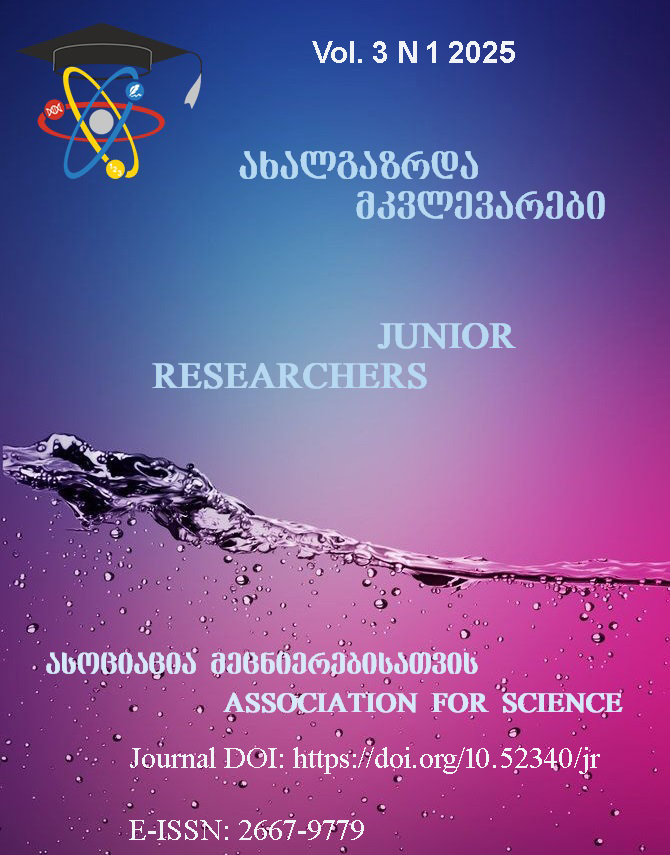Abstract
It is very important today to conduct chemical reactions using the concept of green chemistry [1]. The paper develops an efficient and environmentally safe method for the synthesis of 3,3 '- (phenylmethylene)bis(2-phenyl-1H-indole) based on the condensation of 2-phenylenindole and benzaldehyde. In order to optimize the reaction conditions, the synthesis is carried out under different conditions. In particular, the reaction was carried out without solvent, in a water area, in a mixture of ethyl alcohol and water with different volume ratios, using a catalyst. It was found that in almost all cases the reaction went with high yield (> 85%). The duration of the reaction is remarkable. The best result was achieved, when we used water as a solvent: a mixture of ethanol in a ratio of 1: 1, and as a catalyst - salicylic acid (optimal amount of catalyst 15 mol%).
References
Gogrichiani, E. O., Katsadze E. A., Gavtadze, N. G., Samsoniya, S. A., & Duerr, H. Derivatives of Indole. Part 143. Synthesis of Photochromic Derivatives of 2‐Arylindoles. (2005). ChemInform, 36(27).
Pal, Rammohan & Khannobis, Shampa & Sarkar, Taradas. First Application of Fruit Juice of Citrus Limon for Facile and Green Synthesis of Bis- and Tris(indolyl)methanes in Water. Chemistry Journal, 2013, vol. 03, Issue 01, pp. 7-12.
Shiri, M.; Zolfigol, M.A.; Kruger, H.G.; Tanbakou-chian, Z. Chem. Bis- and trisindolylmethanes (BIMs and TIMs) Rev. 2010, 110, 22502293, DOI: 10.1021/cr900195a
D.Xu; Z.Xu; Curr. Indole Alkaloids with Potential Anticancer Activity. Top.Med. Chem., 2020, 20, 1938–1949, doi: 10.2174/1568026620666200622150325
T.P. Singh; O.M.Singh. Recent Progress in Biological Activities of Indole and Indole Alkaloids. Med. Chem., 18, 2018, 9–25, doi:10.2174/1389557517666170807123201.
Vishali Garg; Rahul Kumar Maurya; Punniyakoti Veeraveedu Thanikachalam; Garima Bansal; Vikramdeep Monga. An insight into the medicinal perspective of synthetic analogs of indole: A review. Eur. J. Med. Chem., 2019,180, 562–612, doi:10.1016/j.ejmech.2019.07.019.
A. Kumari; R.K. Singh. Medicinal chemistry of indole derivatives: Current to future therapeutic prospectives. Bioorg. Chem., 2019, 89 103021, doi:10.1016/j. bioorg.2019.103021.
(a) V. Sharma; P. Kumar; D. Pathaka. J. Heterocycl. Biological importance of the indole nucleus in recent years: A comprehensive review. Chem., 2010, 47, 91–502, doi:10.1002/jhet.349; (b) M. Hublikar; V. Kadu; D. Raut; S. Shirame; S. Anbarasu; M.K. Al-Muhanna; P. Makam; R. Bhosale. 3-Substituted-2-oxindole derivatives: Design, synthesis and their anti-tuberculosis and radical scavenging dual-action studies. J. Mol. Struct., 2022, 1261, 132903, doi: 10.1016/j. molstruc.2022.132903.
N. Chadha; O. Silakari; Indoles as therapeutics of interest in medicinal chemistry: Bird's eye view. Eur. J. Med. Chem., 2017, 134, 159–184, doi: 10.1016/j. ejmech.2017.04.003.
S.A. Morris; R.J. Andersen. Brominated bis(indole) alkaloids from the marine sponge hexadella SP. Tetrahedron, 1990, 46, 715–720. https://doi.org/10.1016/S0040-4020(01)81355-7






